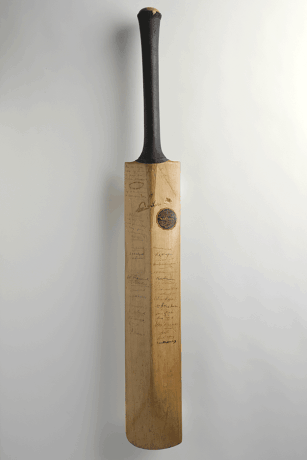The Grigoryan Brothers - "This is Us" - A Musical Reflection of Australia
Acclaimed guitarists Slava and Leonard Grigoryan have created a suite of music inspired by objects personally selected from the National Museum of Australia’s vast collection, tracing Australia’s diverse and complex history.
Each composition focuses on a particular object, projected during the performance to enhance the audience experience. Among them: a convict love token, a case of lenses and frames from Fred Hollows, and a cricket bat from the famed Sir Donald Bradman.
Incorporating all their influences from classical to jazz and contemporary music and performed on a variety of guitars, This Is Us is a personal declaration from Slava and Leonard, that this music, composed during lockdown with each living in different states, is a new direction for them. The intangible virtuosity that has solidified this duo as some of the finest musicians of their generation shines through in this stunning original work, inspired by Australia.
Performance 1 - Love Token
Introduction and Performance
Performance Only
Love Token: A response to a convict coin
Inspired by convict love token, Slava and Leonard Grigoryan's Love Token is a musical response to an engraved convict coin.
Engraved coins like this one are known as “love tokens” and were gifted as mementos to loved ones. The coin is housed in the collection of the National Museum of Australia.
Smoothing and engraving a coin with a message of affection was one of the few ways a convict could leave a memento with a loved one in England.
This token, inscribed in 1819, bears the words, "Dear brother when you see this remember me when I am far away."
— Curator, National Museum of Australia
Performance 2 - Fred’s Vision
Introduction and Performance
Performance only
Fred's Vision: A response to the work of Fred Hollows
Professor Fred Hollows was an Australian surgeon and humanitarian who worked to improve the eye health of people living in under-privileged circumstances in Australia and overseas.
He was director of the National Trachoma and Eye Health Program in Australia from 1976 to 1978, which sent teams of ophthalmologists and support staff to regional and outback Australia, including 465 Aboriginal communities. He also worked across Africa and Asia to empower communities to restore people's sight.
This case of trial lenses and frames from the national trachoma program relates to Hollow’s pioneering work in the field. Eye examinations were conducted in makeshift medical sites, sometimes in tents, sometimes on the side of the road.
Fred Hollows died in 1993 but the Fred Hollows Foundation continues to campaign for blindness prevention and improved health for Indigenous Australians.
— Curator, National Museum of Australia all about Fred’s vision
Performance 3 - Don’s Bat
Introduction and Performance
Performance Only
Don's Bat: A response to Sir Donald Bradman's cricket bat
Slava and Leonard Grigoryan's Don's Bat is a musical response to the cricket bat used by Sir Donald Bradman in the first Test of the 1934 Ashes series. This bat was used by Sir Donald Bradman in the first Test Match against England at Trent Bridge, Nottingham, during the 1934 Ashes series, which was won by Australia.
As a child in Bowral, New South Wales, Bradman had always played with second-hand bats given to him by older players. When he was 17, his mother promised to buy him a new bat of his own if he made a century in a match playing for Bowral against Moss Vale.
Bradman made 300 in the first innings of this match and his mother kept her promise. Bradman chose a bat made by William Sykes and Sons of Yorkshire. He continued to use this brand, almost exclusively, for the rest of his cricketing life.
During his career he scored 6,996 test runs and 28,067 first-class runs for New South Wales and then South Australia. Bradman continues to hold the record for highest test batting average at 99.94.
— Curator, National Museum of Australia
How will that special guitar help you take the next step?
For more details on our range of guitars, please click here
Like this performance?
Click here to subscribe to our YouTube channel and never miss a performance.
Don't forget to click the Facebook icon below to share this with your friends.




